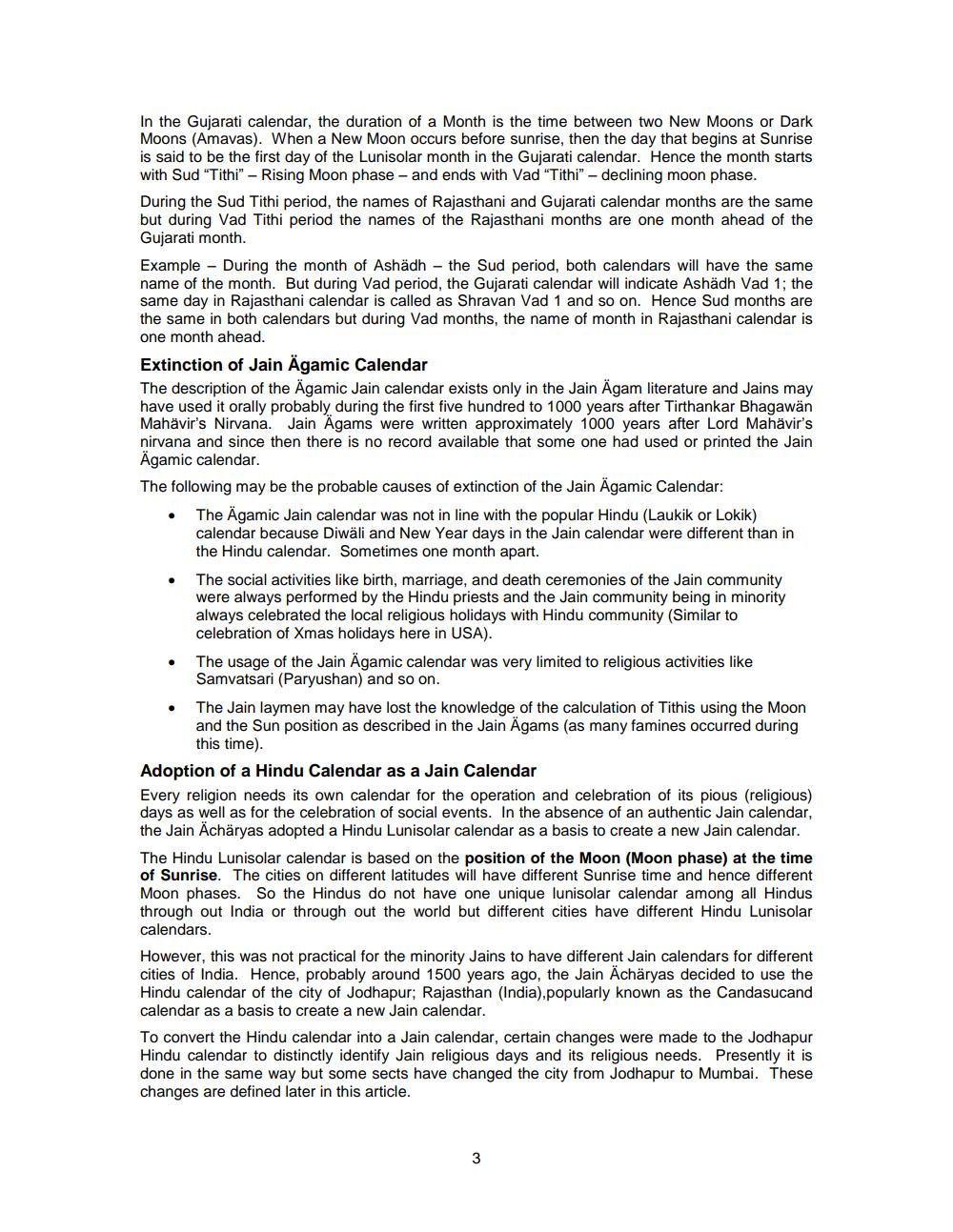Book Title: Samvatsari Tithi Article V4 20120905 Author(s): Pravin K Shah Publisher: JAINA Education Committee View full book textPage 3
________________ In the Gujarati calendar, the duration of a Month is the time between two New Moons or Dark Moons (Amavas). When a New Moon occurs before sunrise, then the day that begins at Sunrise is said to be the first day of the Lunisolar month in the Gujarati calendar. Hence the month starts with Sud "Tithi" - Rising Moon phase - and ends with Vad "Tithi" - declining moon phase. During the Sud Tithi period, the names of Rajasthani and Gujarati calendar months are the same but during Vad Tithi period the names of the Rajasthani months are one month ahead of the Gujarati month. Example - During the month of Ashädh - the Sud period, both calendars will have the same name of the month. But during Vad period, the Gujarati calendar will indicate Ashädh Vad 1; the same day in Rajasthani calendar is called as Shravan Vad 1 and so on. Hence Sud months are the same in both calendars but during Vad months, the name of month in Rajasthani calendar is one month ahead. Extinction of Jain Ägamic Calendar The description of the Ägamic Jain calendar exists only in the Jain Ägam literature and Jains may have used it orally probably during the first five hundred to 1000 years after Tirthankar Bhagawän Mahavir's Nirvana. Jain Ägams were written approximately 1000 years after Lord Mahavir's nirvana and since then there is no record available that some one had used or printed the Jain Ägamic calendar. The following may be the probable causes of extinction of the Jain Ägamic Calendar: ⚫ The Ägamic Jain calendar was not in line with the popular Hindu (Laukik or Lokik) calendar because Diwäli and New Year days in the Jain calendar were different than in the Hindu calendar. Sometimes one month apart. The social activities like birth, marriage, and death ceremonies of the Jain community were always performed by the Hindu priests and the Jain community being in minority always celebrated the local religious holidays with Hindu community (Similar to celebration of Xmas holidays here in USA). The usage of the Jain Ägamic calendar was very limited to religious activities like Samvatsari (Paryushan) and so on. The Jain laymen may have lost the knowledge of the calculation of Tithis using the Moon and the Sun position as described in the Jain Ägams (as many famines occurred during this time). Adoption of a Hindu Calendar as a Jain Calendar Every religion needs its own calendar for the operation and celebration of its pious (religious) days as well as for the celebration of social events. In the absence of an authentic Jain calendar, the Jain Ächäryas adopted a Hindu Lunisolar calendar as a basis to create a new Jain calendar. The Hindu Lunisolar calendar is based on the position of the Moon (Moon phase) at the time of Sunrise. The cities on different latitudes will have different Sunrise time and hence different Moon phases. So the Hindus do not have one unique lunisolar calendar among all Hindus through out India or through out the world but different cities have different Hindu Lunisolar calendars. However, this was not practical for the minority Jains to have different Jain calendars for different cities of India. Hence, probably around 1500 years ago, the Jain Ächäryas decided to use the Hindu calendar of the city of Jodhapur; Rajasthan (India), popularly known as the Candasucand calendar as a basis to create a new Jain calendar. To convert the Hindu calendar into a Jain calendar, certain changes were made to the Jodhapur Hindu calendar to distinctly identify Jain religious days and its religious needs. Presently it is done in the same way but some sects have changed the city from Jodhapur to Mumbai. These changes are defined later in this article. 3Page Navigation
1 2 3 4 5 6 7 8 9 10
